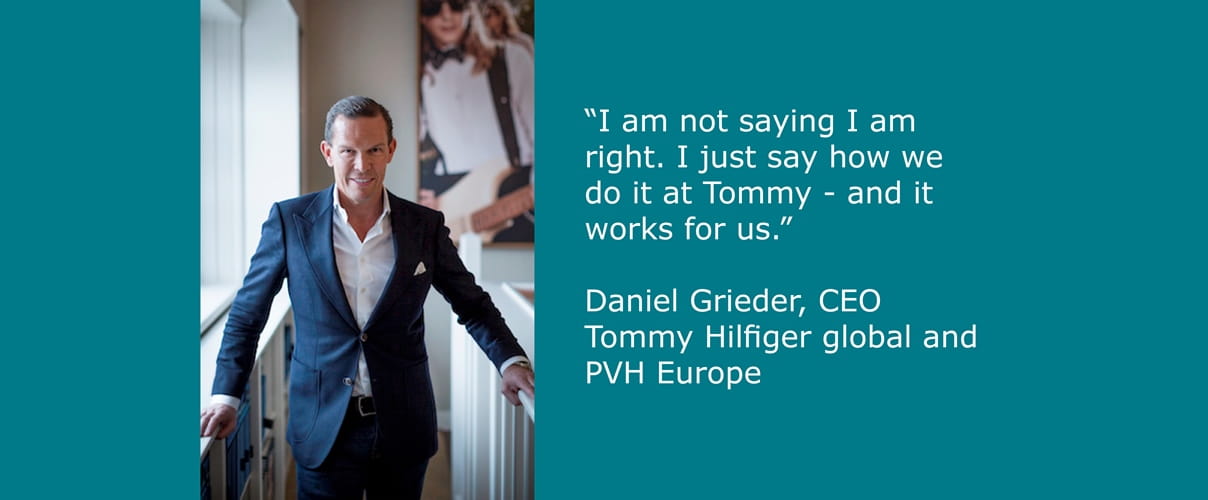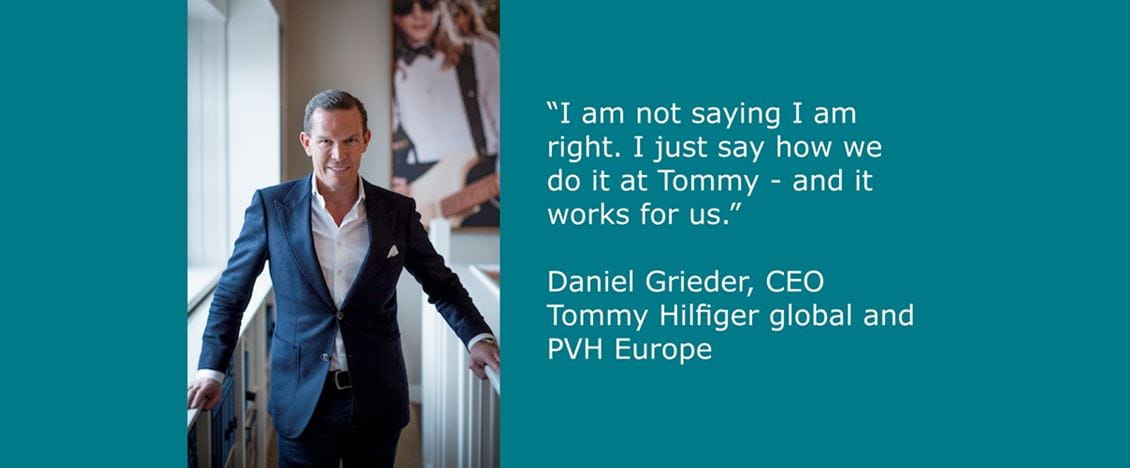Who is behind Tommy Hilfiger?
Sherin Keller
Place yourself in front of a mirror. Does a red, white and blue flag flash somewhere? Then you are a customer of Tommy Hilfiger. Not only does Hilfiger himself take the scepter, but Daniel Grieder, Swiss top manager and graduate from a Zurich university of applied sciences. He has talked about brand management, a corporate culture that encourages innovation and allows mistakes, Gigi Hadid and stubbornness.
Daniel, when you look at your company appearance, you always come across as perfect. Preppy Tommy Family – the perfect world. Does everything always run smoothly? Do you ever make mistakes?
Ah, what do you think! Of course we make mistakes. A lot. And then we get up again and do things better. We have already invested in the wrong product, we have launched ineffective campaigns, we have built shops with bad systems, we have bet on the wrong people … Quite honestly, mistakes happen almost every day.
Where entrepreneurial, courageous people work together, who like to experiment and are not afraid to fail, creative and sometimes crazy ideas are created. Many are implemented, many not. Our luck or our skill – or a combination of both – is that in the end, it works out more often than it does not.
Quite concretely, what do you do differently from those fashion companies that have to register for insolvency, go bankrupt or have to go through a thorough renovation?
We do not rest on our accomplishments, but reinvent our product every day. We are creating a story around our product and we have invested early in digitization.
It is a dangerous attitude to think a brand's appeal will never fade when it's at the top. In any case, we cannot afford to do this and so we always think about how we can develop our products further and address all age groups. While in certain areas we strive for consistency and stability, for example, in the quality and the offer of the basics, we look for change and variety in other areas. We play with our logo and lettering, place visible or even non-obvious applications and try to surprise the customers again and again. At the moment, the 90s are re-emerging and we have anticipated this with large, intrusive logos and embroidery. But we will stop again early enough and place more subtle accents.
Our products are also therefore not naked. We embed them into a Tommy story and present them in the context of elaborate shows. What our brand embodies, we try to communicate and transport with our brand ambassadors.
Digitization is ultimately something we have been focusing on for years. How do our customers buy in an increasingly digital world? In 2015, our first digital showroom went live. In London we are running the prototypes of our shop of the future and collecting hard data. We already have a lot of money invested in digitization and the digital showrooms have a high return on investment. Here we are really ahead of the competition.
You could read a lot about the Digital Showroom and the Store of the Future. Let's talk about your brand ambassadors. You seem to have a good hand in the selection. How do you do that?
With trend- and talent scouting ... and indeed also with intuition and luck. I remember the beginnings of the collaboration with Gigi Hadid. We liked her, her authenticity, her coolness. She has character and today she is one of the most popular supermodels ever. The Capsule Collection, which we designed with her, sells very well.
Also in our latest collaboration with The Chainsmokers, there was a lot of gut feeling in the game. In America, the DJs were quite well known when we were attracted to them, but less so in Europe. We went to concerts, got to know the guys – and today they are under contract with us. Let's see how they evolve.
You emanate entrepreneurial spirit and passion for your brand. How do you transfer this spirit to your employees?
We do a lot to inspire and promote this spirit across all hierarchies. This starts with the fact that the employees in our company can be themselves, and express their opinions. This is what I ask in person to the 65 employees starting every month. And the spirit is lived! The employees come to me and my management team with ideas and feedback. Even Tommy is available. He is interested in our people and has an open ear for suggestions. We recently delivered an elevator pitch. It was an experiment at the directors' level, which we shall surely repeat at further levels. The directors had three minutes to present an idea. In the end, so much great input came together that the teams were allowed to develop business cases. The so-called endless-aisle in our shops of the future is a result of the Elevator Pitch.
In general, we try to create a working atmosphere in which one likes to work. We regularly inform about our business, where we stand and where we are going. We organize employee meals and events, for example, for Christmas last year we all got a bike. We have already talked about our error culture: everyone can make mistakes – as long as they learn something from them. We are trying to create a work environment in which everyone wants to contribute to the overall success. People who catch fire for our vision and contribute with their ideas, their passion and their energy, so that we can achieve our goals step by step, can quickly assume responsibility and advance.
Yes, and people who do not share your opinion have it hard, right? One could come to this conclusion when reading previous interviews. You there describe how you have compiled your core team for the development of the digital showrooms. Are you stubborn?
No! Basta. [Laughs]. I was looking for people to join the venture of the digital showroom. If someone tells me, "That's not possible," that's okay. Those are their limits. But not mine. ‘Make the impossible possible’ is a part of our corporate culture. I am not stubborn, but I have visions, beliefs and passion! This drives me. But that doesn’t mean that I cannot be convinced of another point of view. I always listen to different opinions, question my argument, re-evaluate, search for the conversation repeatedly. And I will also reflect on stubbornness afterwards.
###
Hier gelangen Sie zur deutschen Fassung des Interviews mit Daniel Grieder.





